Illustrations by Robert M. Dunker
Videos by VICE

I only learned the secret of Horseshit magazine last year, while patronizing a local military-surplus shop. It was one of those menacing and increasingly rare army-navy stores popularized in 1993’s Falling Down—grimly dim, decorated with Nazi artifacts and dangling gas masks. I got the feeling it was the kind of place where one must be careful not to wander too far toward the back room, lest one never come out. Even as the shopkeeper chatted with another customer, I could feel his eyes watching me.
In front of one counter displaying Luftwaffe cufflinks and K-rations, I found myself staring at a publication titled Horseshit. The cover featured a crisp illustration of a man with a face wrapped in barbed wire. It recalled Winston Smith’s cover of the Dead Kennedys’ Give Me Convenience or Give Me Death. Clearly, I thought, this was a punk zine I’d never heard of. What was it doing here? I opened it and immediately discerned three things:
1) The magazine predated punk by at least ten years.
2) It was full of extremely arousing drawings of nude women.
3) It was also full of disturbing antimilitary propaganda (babies on bayonets, marines as drooling ghouls) that, if the guy behind the counter knew what I was looking at, would probably result in my ass getting kicked.
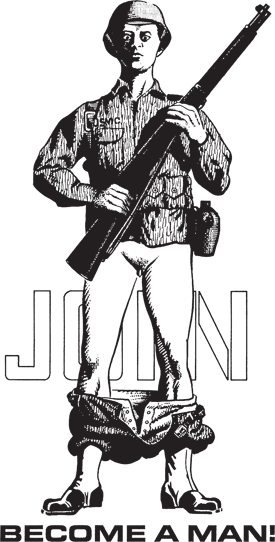
I looked up. The owner was indeed staring straight at me, even while conversing with the other customer.
“Excuse me,” I said as I lifted the magazine. “How much for this?”
The two men stopped talking. The owner sized me up with undisguised disgust.
“That’s NOT for sale,” he finally replied. I nodded and backed out the front entrance, his hateful death-ray gaze following me onto the street.
It was a confusing and mysterious introduction to a confusing and mysterious magazine.
Later I scouted for clues about Horseshit online, but there weren’t many. I learned from one website that the magazine was published by two brothers, Thomas and Robert Dunker (Thomas, a paraplegic, died in 2003). In 1968, Horseshit was responsible (along with Zap, Snatch, and the SCUM Manifesto) for the arrest of Berkeley bookseller Moe Moskowitz on charges of selling pornography. A year later, Frank Zappa referenced the magazine in his track “German Lunch.” Beyond those two intriguing historical morsels, Horseshit occupies a void. A few online booksellers offered complete sets of the magazine—all four issues for $150.
By chance I found a website selling the set for considerably less, and I jumped at the opportunity. But as soon as I placed the order, I felt duped. Was it really possible that this magazine had slipped under the radar of everyone I knew? A dark paranoia festered: It all began to feel like an elaborate scam that would end with the eBay seller and the aggressive military-surplus-store guy splitting the cash down the middle.

Two weeks later, the magazines arrived. The cover of issue 1 features line art of a US Army soldier of indeterminate rank cradling an automatic rifle. His other hand is holding aloft an apparently dead infant that he has just bagged, like a mallard. Below the magazine’s title is the legend the offensive review and, under this, in the bottom corner, ATTACK! The fine print informed me that it was published by Gauntlet Press of Hermosa Beach, California. Incredibly, the magazine is dated 1965.
The issue begins with a polite and brief intro: “Some time ago, two young men, brothers named Bob and Tom Dunker, decided that there was a real need for a magazine that would combine strong, fearless, humorous drawings with witty, intelligent, outspoken writing… Remember that when you read an ordinary magazine, you are reading what some writer thinks you will want to read, not his own opinions… Horseshit doesn’t have this problem. It is the work of men, not the product of a committee.”
The first article, “On Naming the Magazine,” depicts a dramatic dialogue in which three characters brainstorm magazine titles. The characters conceive and debate a long list: Asshole, The Clitoris, Contraceptive (“It’s no good, you can’t send contraceptives through the mail”), The Cow Flop, Cunts I Have Known, The Curse, The Diarrhea of Anne Frank, Dildo, Flatulence, The Hermosa Bitch, The Hermosa Rag (“a monthly”), The John, The Masturbation Manual, The Nocturnal Emission, Nooky, Prick, Screw (three years before Al Goldstein’s Screw), Self Abuse for the Obtuse, The Shaft, The Strumpet, Supposi-Stories, Ten Inches, The Toilet Paper, Twat, Urine, and Washington’s Monument.
Right out of the gate, Horseshit’s publishers have some self-referential fun with the absurdity of their situation and eventual creation:
Bob: The Whore’s Home Companion?
Gordon: Right, a magazine designed to be read in the parlors of whorehouses while waiting your turn to go upstairs. [The character of Gordon, perhaps based on a real-life third partner, vanishes after this brief appearance.]
Other articles include:
• An odd short story from the perspective of an East Indian villager
• Four pages of adult aphorisms (“Life is a slut, full of hidden sores and secret smells”) and dirty poetry
• A personal reminiscence on sex education
• “Ready, White, and Blue,” a four-page antimilitary pictorial drawn in the blocky style of contemporary political cartoons
• A one-page short story “The Plot to Kill the Queen,” which ends with a finger-in-the-hole-of-a-dyke pun
• An eight-page sketchbook full of naked young women with gloriously furry crotches
• A ten-page teleplay about patients in a VA hospital
• An editorial about statutory rape (the Dunkers apparently disapproved of adults being imprisoned for having sex with consenting minors)
• The two-page “Support Your Loco [sic] Police”
• “Boob Golf,” a cartoon spread that clearly belonged in Playboy
In Horseshit I saw the clear outlines of aesthetics later used by the Church of the SubGenius, Crass Records, Devo, the Feederz, and Raymond Pettibon. As a former voracious fanzine collector, I marveled that I’d never heard of it (incidentally, Thurston Moore, allegedly a major zine collector, turned down my interview request for this article). I kept returning to my weird doubt: Was the magazine an elaborate hoax produced in the 21st century? Wilder things have happened.
It’s useful to take stock of how weird and different 1965 was compared with modern times. It was much more Mad Men than Woodstock. Mad magazine had instigated American youth culture’s shift toward the anarchic left, but it would be almost a decade before they published their infamous middle-finger cover. National Lampoon had yet to be conceived, and Monty Python’s debut was four years away. The Dunkers’ focused, antagonistic nonconformity was extremely jarring in a time when unabashed dissent was a nascent form of expression. Next to someone like Lenny Bruce—whose solo stand against the agents of prudishness at least resulted in lasting notoriety—the Dunkers barely garnered any cultural significance whatsoever. What’s most amazing is that Horseshit offered something several shades beyond nonconformity without a support system of any kind—no powerful rock-star friends, no charitable lefty lawyers to get them out of sticky jams, and no masses of youth willing to help their cause.
The varied styles of art in Horseshit suggest several different artists. The illustrations are professional yet uncompromising, perfectly capturing the nonconformity of the Dunkers. There are studied line-art nudes (mostly, but not exclusively, women), sloppier crosshatched nudes, staid little spot illustrations, and frenzied doodles of military brutes and sexual perversions. The magazine’s signature typographic bullet—a pictograph of a hand giving the middle finger—looks like the polished logo of a hip contemporary skateboarding company. Until I read the words “all the drawings in this magazine are by Robert M. Dunker,” I thought at the very least that the Dunkers had tapped into some sort of mid-60s adult clip-art treasure trove. Considering the intentionally marginal nature of the magazine juxtaposed with the professional artwork it contained, I wondered whether other periodicals had swiped Dunker’s work over the years as if it were royalty-free clip art. I would discover later that many, including Playboy, allegedly did just that.
Horseshit’s obvious contemporary, Fuck You: A Magazine of the Arts, had access to a high caliber of early-60s thinkers and artists: Burroughs, Ginsberg, Warhol, and others. Fuck You’s presentation, however, was amateurish ephemera—a junior high schooler’s mimeographed poetry zine. If you can ignore its title, Horseshit is a slick, serious publication that would be just as at home in a doctor’s office as in a brothel parlor.
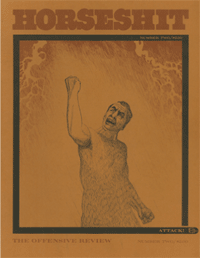
Issue 2 is dated 1967. The format remains the same, but by this time the Dunker brothers had changed the name of their publishing company from Gauntlet (a preexisting “homosexual publication”) to Scum. It also seems like they were expressing even angrier sentiments than those in the first issue, opening with a story about a young man who refuses to be thrown into a volcano, and this statement: “If you haven’t caught on that our society uses human sacrifice, don’t read this magazine.
Horseshit is a message from the jungle. It is dangerous. If you read it, you may find yourself agreeing with some of the things we say. Then people will think you are either crazy or a traitor. Go watch human sacrifices instead. Maybe you can be next.”
Contents include:
• “Canonize JFK Now”: a piece mocking the martyrdom of Kennedy with deep, acidic sarcasm
• “Cunt Is a Christian Word”: A dreadful two-page poem (“There is no cock as big and rough as the one your church has thrust in you”) with an exquisite layout. Curiously, one illustration of a spread-eagled naked woman omits her genitalia. Possible self-censorship?
• An article on providing sexual education to federal judges
• “The Fetishist,” a comic featuring a deviant anthropomorphized shoe in which the shoe man locks the bedroom door, goes to the closet, finds a rack of small human beings, and ecstatically rubs one out all over its shoe body before a bunch of police shoes kick in the door
• “The Last Words of Jefferson Monroe Just Before He Was Torn to Pieces on the Floor of Congress,” written in the style of a contemporary teleplay, but with lots of non-contemporary language (Sample dialogue: “All you do is suck on the assholes of your rich masters!”)
• Ten pages of whimsical “Patriotic Drawings” that look like they belong in a dirty-minded kid’s coloring book
• A six-page spread on the Kama Sutra, written like an explicit Mad gag
• A two-page spread of jokes about women
• A page of “Quickies,” including a chastisement of black Muslims: “The Muslims have been spending their time talking about the white man as though he were a devil and implying that he ought to be wiped off the face of the Earth. And yet, have they ever killed anyone? There is no evidence that they ever have. How can they hope to compete with the Christian churches who have killed millions?”
• A seven-page short story about an army private who goes insane and stalks officers on his own base like a serial killer
• A back-page discussion of Horseshit’s steep $2 price (approximately $13 today): “We can’t get most printers to print it, or typesetters to set our type, or distributors to handle it, or booksellers to sell it. Doing battle with all these idiots naturally runs up our expenses.” Later, the editors offer subscriptions for readers’ enemies
The entire magazine feels oddly isolated. Except for brief nods to the Realist and Eros, there are no references to any sort of American counterculture. (There is, however, one pointed notice that Horseshit is NOT a member of the Underground Press Syndicate.) At this time the Dunker brothers were in their mid-30s, radicalized but disconnected from the organized left. In the truest sense of the words, they were outraged citizens moved to action.
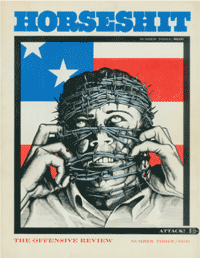
Issue 3, published in 1968, maintains the Dunkers’ rather off-putting honesty: “We put out this magazine for the same reason that little boys run around and shout and make noise. Because we’re alive. That’s all. Because we’re alive.” It also features a marked ratcheting up of the antimilitary sentiment; the writing and graphics are far bitterer. On boot camp, Thomas Dunker proclaims, “The whole training mess is bullshit. An excuse to give the sadists who run the Regular Services a chance to work out their perversions at public expense.” Additionally, the issue offers a selection of the Dunkers’ antimilitary posters (ten for $1), the year of the My Lai Massacre and two years before Jane Fonda and Donald Sutherland’s “F— the Army” traveling stage show.
There’s also an article titled “Committee of the Gods and the Female Tits and Ass,” which ends with, “A man can no more ignore a woman’s ass than a dog can ignore a rabbit—so let’s force them to shape up.” Through the magazine’s run, there is an ample supply of that squishy misogyny of the pre-70s left. In “A Year’s Supply of Excuses for Girls,” the Dunkers offer just that: “He forced me,” “I was too drunk to know what I was doing,” “He said I’d lose my job if I didn’t.” Women are often punch lines, with one article featuring a discussion of females’ “faint” brain waves.
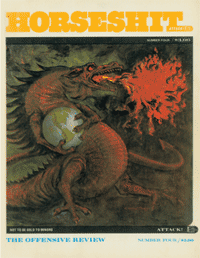
Issue 4 is the big one, which may have something to do with the fact that it was released in 1969. At 56 pages, it’s the longest issue of the bunch, and the first to include an order form inside and a warning on the cover (NOT TO BE SOLD TO MINORS). The very noninflammatory cover art features a painting of a dragon holding the Earth and spitting fire into the ether. But inside is some of the most ferocious content to ever grace the pages of a magazine. Were the brothers Dunker the dragon taking the world back, or inhabitants of the world, held hostage by the dragon?
Contents include:
• “The Nut Growers Foundation,” a seven-page satiric conspiracy piece
• A rather pedestrian—considering the times—piece titled “Old Believe… Young Think” (“Old people think that it is shameful to go to prison. Young people are faintly ashamed that they haven’t had the guts to go to prison”)
• Six pages of “The Circulation of the Blood During the Sex Act,” which features illustrations of fully splayed genitalia that are far more explicit than what’s found in issue 2
• The two-page “How Flowers Mate… and Eliminate” with an unexpected jab of (ironic?) racism when, among the naughty flowers with fully engorged phalli and boobs, one particularly large, droopy schlong is labeled NIGGER FLOWER
• A 16-page short story, “The Lesson They’ve Been Trying to Teach Us,” which begins as kid-on-kid (as in minors fornicating with other minors) porn and devolves into an incest tale. The story is written in an off-putting, genuine manner that seems to have an ambiguous political point (Americans are too sexually uptight? It’s OK for juveniles to have sex with one another?). Jarring and deeply creepy, the piece is a fitting grand finale to the magazine
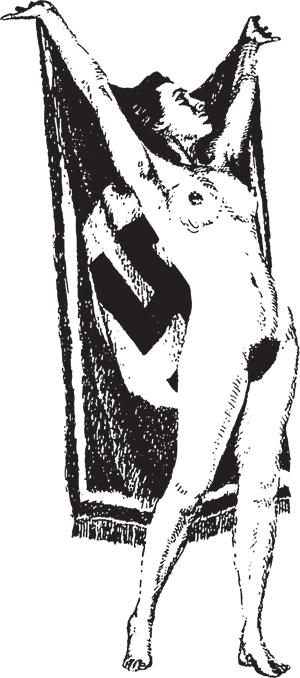
When I finally reached the elusive Robert Dunker, I learned that he lives only 45 minutes from the store where I first discovered his magazine. Now an octogenarian, he was polite and gracious enough that I resisted saying “
Horseshit,” lest I offend him (I referred to it as “your old magazine”).
Robert filled in the gaps of a surprisingly prosaic upbringing. The brothers grew up on a farm west of Sioux Falls, South Dakota, suffering a childhood out of a Norman Rockwell painting (“…a mile through the snow to the school bus. Then, after school, we’d get home and work until dark”). He also told me that he served in the marines, and that Tom was drafted into the army (years before his paralyzing accident) after leaving the seminary on the grounds that it was “nonsense.”
I asked whether their military service had served as an agent of radicalization. Had there been a particularly scarring incident? How does one’s rage meter go from 0 to 100 so quickly and forcefully?
“I don’t think that there was such an incident that caused anything like that,” Robert told me. “What happened was, our parents were exceedingly devout. They got down on their knees and prayed for peace every night with their rosaries. And to me, in my mind, I never accepted any of that. We went to a parochial Catholic school, and I always was just looking around, wondering, ‘Am I different or crazy? I don’t believe any of this…’ I think there are people in the world who are believers. They’ll believe any damn thing, whether it’s Bigfoot, flying saucers, or whatever. Then there are people who won’t believe anything, unbelievers. And I think my brother and I are just unbelievers.”
Did the brothers, I asked, have any connection to the beat culture when they started their magazine in Hermosa Beach?
“No,” Robert said. “Most of the activity for the hippies was in San Francisco and downtown LA. And we didn’t know anybody like that. Once our magazine got to be well known, we got invitations to all the rock shows or whatever they were at that time. I never went to any of them. I’m antisocial. And because Tom was in a wheelchair, he couldn’t go to them. So we never really met people like that. There were certain ones who came and visited Tom, and he would tell me about it afterward. I can’t even remember their names.”
By this time, the conversation had taken on a strange tone. It felt like we were discussing a journal of macramé. I marveled at the professionalism of the magazine (in all four issues, I found only one typo and one shadow line). Robert told me he had worked for the electronics divisions of several aircraft companies, designing and illustrating brochures. Somehow this wasn’t the exciting explanation I had hoped for. I also inquired if it was true that Horseshit had been originally distributed inside a brown paper wrapper. It was.
“We wanted people to read it, but we realized that if we put a big stamp that said Horseshit… the post office at that time considered itself censors of everything that went through the mail, and consequently if they opened it up, they would just return it or destroy it.”
What about legal troubles? There were none to speak of. How about their family? Were relatives aware of their little deviant pet project? Had their parents disowned them?
“We never sent it to them,” Robert said. “We never mentioned it to them, there was never any back and forth. Our relatives were all wonderful people, but they weren’t in favor of anything we ever did, so we considered ourselves black sheep. But we kept on good terms with them.”
The story was almost unbelievable. How could the Dunkers have produced such a scathing attack on everything—in the 60s, no less—without immediate and dramatic negative results? I suddenly felt like a caricature of a bad reporter, barely able to contain his annoyance at not receiving the story he wanted to hear.
The magazine ended, Dunker told me, because the conclusion of the Vietnam War made Horseshit irrelevant (odd chronology, considering that Vietnam raged for another half decade). Additionally, Robert said, their struggles with typesetters, printers, and distributors had become unmanageable. It was an entirely reasonable and logical conclusion.
And what of the years since? You could fit an entire lifetime (mine, for example), in the gap between issue 4 (a planned fifth issue never materialized) and our phone call. Here too, Robert’s tale was surprisingly upbeat:
“My brother was a paraplegic, and he spent a lot of time in the hospital. He hated hospitals and never wanted to go back to a VA. So we decided to make some money so that he could live on his own. We invested well. We bought houses for nothing down and remodeled them. My brother made the calls and handled the contracts, and I did the labor. Eventually we had two crews of people working for us. We made a good deal of money. I still have houses that provide me with rental income. And Tom had exactly what he wanted, a nice house on the beach. We had five people on call all the time, so there was somebody either with him or close by 24 hours a day. During his last ten years he needed somebody to help him up and out of bed and do things for him, and so it worked out fine for us.”
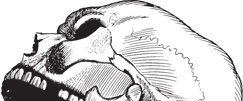
More
From VICE
-

Collage by VICE -

Collage by VICE -

Collage by VICE -

(Allen J. Schaben / Los Angeles Times via Getty Images)
